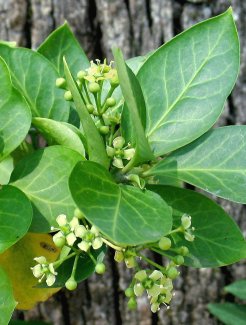Native to Asia, from Japan to the Philippines
E. fortunei grows as an evergreen, woody, clinging vine climbing to 12-22 m (40-70 ft) with the support of aerial roots, or it can form a dense groundcover or low shrub to 1 m tall. The leaves are variable in colour and size. Leaves can be "dark green, green-white or green-gold variegation with some cultivars having purplish lower surfaces" (Hutchison, 2006). Leaves are "ovate (egg-shaped), 2.5-6 cm (1-2.5 in) long, 2.5-4.5 cm (1-1.75 in) wide, and thick with the base of the leaf tapering to the stalk. The leaf stalk (petiole) is 0.4-1 cm (0.13-0.38 in) long. The leaf margins are finely toothed and somewhat turned under or wavy. The blades are glossy with silvery or whitish veins. Leaves usually occur in pairs, but vigorous shoots may have sections with an alternate arrangement.
Native to Asia, from Japan to the Philippines, it has been widely used as an ornamental plant in temperate and sub-tropical regions around the world. Most reports of naturalization and invasion of E. fortunei are from eastern North America. It was introduced to the USA in the late 1800s or early 1900s. First reports of invasiveness did not appear until the late 1990s.
